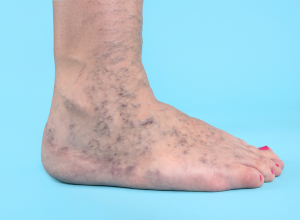
Varicose Veins
Varicose veins are veins that have become visibly gnarled and enlarged. They typically occur in the legs and feet due to increased vein pressure in the lower extremities. Less extreme varicose veins are called spider veins.
Symptoms
Most varicose and spider veins are painless and are simply a cosmetic problem. The condition is characterized by large purple or blue veins that often appear twisted and/or bluging. The affected veins can appear anywhere, but they are usually present on the thighs, lower legs, ankles and feet.
Some varicose veins become so gnarled and large that they create pain and discomfort. These abnormalities (called varicosities) may make your legs and feet feel heavy, throb, burn or cramp up. These symptoms are usually worse after sitting or standing for long periods of time.
Spider veins are similar to varicose veins but are much smaller. They are usually red or blue and appear very close to the skin’s surface.
Causes
Varicose veins form when the veins lose elasticity or experience difficulty returning blood to the heart, which allows deoxygenated blood to pool. There are many things that can cause this, including:
- Age
- Obesity, which creates extra pressure on the veins
- Pregnancy, which increases blood volume but decreases blood flow from the legs to the pelvis. Additionally, the extra weight of the uterus creates greater pressure on the veins in the lower extremities
- Birth control pills
- Occupations that involve a lot of sitting or standing for long periods of time
- Postmenopausal hormone replacement
- A history of blood clots or conditions that create extra pressure on the abdomen and lower extremities, such as a tumor or chronic constipation
Conservative Treatment
Usually varicose veins adn spider veins do not need treatment. However, if your varicose veins are causing discomfort, then exercise and elevation are recommended to help with circulation, as is losing weight if you are obese, avoiding tight clothing and decreasing the frequency in which you are sitting and/or standing for long periods of time. Wearing compression socks may also help venous conditions, as they steadily squeeze the limbs and help veins move blood more efficiently.
Varicose veins created by pregnancy typically heal on their own several months after delivery.
Surgical Treatment
In rare circumstances, varicose veins can lead to ulcers (particularly around the ankles) and blood clots (thrombophlebitis). Therefore, severe case of varicose veins may need surgical treatment. Options typically include endovenous laser removal, catheter-assisted procedures (which burn the vein shut), sclerotherapy (injections that scar and close the veins), vein stripping, ambulatory phlebectomy and endoscopic vein surgery. Many of these elective procedures are not covered by insurance and recurrence is possible.
Notice concerning medical entries:
Articles having medical content shall serve exclusively for the purpose of general information. Such articles are not suitable for any (self-) diagnosis and treatment of individual illnesses and medical indications. In particular, they cannot substitute for the examination, advice, or treatment by a licensed physician or pharmacist. No replies to any individual questions shall be effected through the articles.






